Nanotechnologies in Construction: A Scientific Internet-Journal @nanobuild-en
Статьи журнала - Nanotechnologies in Construction: A Scientific Internet-Journal
Все статьи: 572
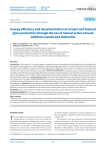
Статья научная
Introduction. In the context of the need to improve energy efficiency and decarbonize cement production, the development of technologies using natural active mineral additives is becoming increasingly relevant. This article examines the use of opoka and diatomite as active additives for producing Portland cement, which allows the clinker content to be reduced by up to 50% while maintaining the operational properties of the cement. Methods and Materials. The research was conducted using electron microscopy, X-ray phase analysis, and energy-dispersive microanalysis. The study analyzed the composition of clinker from SAS-Tobe Technologies, gypsum from the Bagalin deposit, slags from the Novo-Dzhambul Phosphorus Plant, opoka from the Turkestan-Urangay deposit, and diatomite from the Utesai deposit. Physicochemical tests were carried out in the “SAPA” laboratories and at the LLP “SAS-Tobe Technologies” plant. Results and Discussion. The results of the study showed that the addition of opoka and diatomite in a quantity of 15% accelerates mineral formation processes due to the formation of a liquid clinker phase at lower temperatures. This reduces the firing temperature by 100–150 °C, leading to lower energy consumption and improved thermodynamic processes in clinker formation. Conclusion. The introduction of natural mineral additives in Portland cement production reduces clinker content by up to 50%, contributing to energy and resource savings without compromising cement quality. The research results confirm the potential of using opoka and diatomite for decarbonizing the cement industry and increasing its energy efficiency.
Бесплатно
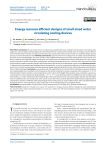
Energy resource efficient designs of small-sized water circulating cooling devices
Статья научная
To use natural sources in rational way, plantsof continuous cooling of closed systems of recycling water supply are used. The paper presents designs of small-sized devices for recycling water cooling which are energy resource effective due to twisted motion of air flow, moving countercurrent to the cooled water. Heat and mass transfer is a nanotechnological process that occurs at the intermolecular level. Methods and materials. Countercurrent mini cooling towers are widely used in all industries, but there are some disadvantages, the main of which is the insufficient interaction time of the moving phases. Screw motion of air flow is created by the tangential supply of cooling air in the bottom part of cylindrical small-sized cooling tower. The rate of rotary motion decreases as air flow moves up in cooling towers, and vertical parameter of the rate – increases. Such scheme of the air flow motionmakes it possible to decrease average vertical parameter of the rate and to increase phases contact time. Laboratory research. To determine the technological and hydroaerothermal characteristics, as well as to estimate the efficiency of cooling recycled water, and to carry out mass-heat exchange at the intermolecular stagean experimental facility of small-sized cooling tower with twisted air flow has been developed. Conclusions. In accordance with the exponential law it is shown that the rotational component decreases at increasing height, and in accordance with the power law the vertical component increases component with the exponent ~1,79. It is determined that moisture content x and air temperature tv in the volume of the height of the sprinkler varies according to a power law, in particular for a screw cooling tower proportionally x ~ h0,83, tв ~ h1,25. It was determined that the coefficients of mass transfer βxv and heat transfer αv of a mini cooling tower with twisted air flow at the intermolecular level with equal irrigation densities are 20% higher than the coefficients of a mini cooling tower with counter-current flow. Also it has been determined experimentally a dependence of aerodynamics resistance coefficient of the twisted irrigator of the cooling tower on criterium Refor air flow, and it was determined that it decreases like Re–K2 as the exponent K2 varies in the range 0.114÷0.193 depending on the irrigation density.
Бесплатно
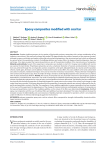
Epoxy composites modified with coal tar
Статья научная
Introduction. Despite significant progress in the creation of high quality polymer composites with a unique combination of key indicators, some issues in this area have not been fully studied. This paper presents the results of research on the structure of materials based on epoxy-coal binder and analysis of physical and mechanical properties at the microstructure level, which are influenced by various factors: the quantitative content of modifying additives and various fillers, the degree of particle dispersion, their size and shape. It has been revealed that nanoscale particles are one of the potential modifiers of the microstructure of composites. Materials and methods. As part of the experiment, composites were studied, in which ED-16 epoxy resin modified with coal tar was used as the main binder. Polyethylene polyamine served as a hardener. Reduction of viscosity and plasticization of compositions was achieved through the use of gasoline, acetone, turpentine, white spirit, dibutylphthalate, etc. Quartz sand, fine powders of brick, marble, glass, limestone, and in addition, Portland cement were used as fillers. Two nano additives were used: carbon black and carbon nanotubes. Standard techniques were used to reveal the mechanical characteristics. Physicochemical investigations were carried out by IR spectroscopy. Tests of samples for fungus resistance and fungicidal properties were carried out in accordance with the State Standard (SS) 9049-91. Results. The results of composite tests are presented in the form of spectrograms, graphical dependencies, and tabular data. Discussion. The results of analyzing the obtained experimental data are presented. The optimum content of polyethylene polyamine for curing of epoxy-coal compositions has been determined. The following has been established: the physical and mechanical properties of composites depend to a great extent on the nature of the solvent, and changes in wide ranges have been recorded. It has been determined that the properties of composite materials are seriously influenced by the dispersity and quantitative content of the filler. The expediency of nano-additives application in epoxy compositions has been revealed. In the course of the experiment the dependences of the change of chemical resistance and biological resistance of composites on the type and quantitative content of the modifying additive, on the nature of the filler were determined. Conclusions. Modified epoxy-coal composites with the use of multilevel fillers and additives have been developed. This makes it possible to increase the strength, increase the deformability and crack resistance of building materials composites for operation, which is very important under the influence of chemical and biological aggressive environment.
Бесплатно
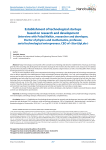
Статья научная
Today technological communities often consider lack of funding and ideas for establishment of startups as the biggest hitch for launching and development of innovative startups for the moment. But that seems to be unsound as the statistics says that there are plenty of financial institutions, venture funds, business angel investors as well as incoming offers from startups showing that there is a host of ideas. One of the most significant tasks in the international technology community is the development of technology entrepreneurs who are able to approach the establishment of their technological startups insightfully. As a rule, such entrepreneurs launching startups are focused on the process of design and development of a unique device, software and other products which they find outstanding, and only after that such issues as: who needs this product and how this product is going to be built into the manufacturing chain are considered by them. A technology entrepreneur with strong technology skills should direct his efforts to the market and end user. In the USA, Israel, Canada and European countries, this function is performed by the inventor, developer, scientist. Therefore fostering of skills of technology entrepreneurship is a very significant factor which allows inventors, developers and scientists to get basic knowledge of entrepreneurial activities and realize their own ideas at early stages. We will try to answer the basic questions which allow scientists, developers, and engineers to build a successful business based on their own developments and research.
Бесплатно
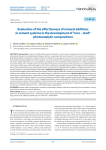
Статья научная
Introduction. Creation of highly efficient photocatalysts for construction composites, which are characterized by increased activity and an extended spectral range of action, is a very important area of research. It is known that “core (substrate) – shell (photocatalyst)” compositions, where mineral raw materials of various genesis can act as carriers, are one of the most effective types of photocatalytic additives for cement systems. It is worth noting that for integrated assessment of the substrate efficiency, we need to obtain information on the composition and properties of raw materials used among which its chemical activity and structure-forming role in cement systems are of paramount importance. The purposes of this study are (1) to establish the influence pattern of four types of mineral additives (silica fume, metakaolin, expanding sulfoaluminate modifier and microcalcite) on the structure formation processes of plasticized cement systems and (2) to identify the most effective modifiers for further use as mineral substrates in the photocatalytic compositions. Methods and materials. Specific surface area and granulometric composition of mineral modifiers were determined by the Kozeny-Karman and laser diffraction methods. The phase composition of mineral additives and modified cement systems were studied using X-ray diffraction phase analysis. Results and discussion. Features of mineralogical and granulometric compositions of mineral additives were revealed. It was determined that the use of individual and complex mineral additives based on silica fume, metakaolin and ESAM made it possible to directionally influence on content of the main phases of cement stone such as ettringite, portlandite, calcium hydrosilicates of different basicity. Conclusions. The increased chemical activity of these modifiers in cement systems, due to presence of reactive minerals in the structure, along with features of the granulometric composition (high dispersity and narrow particle size distribution), indicated the potential prospects for their use as mineral substrate in “core – shell” photocatalytic compositions.
Бесплатно
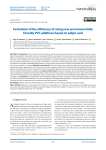
Статья научная
Introduction. The economic activity of a person entails environmental, economic and social damage to the environment. The production of goods or services is associated with the consumption of natural resources and emissions that negatively affect the ecological state. Currently, there is an acute problem of the negative impact of man on the natural environment and is the main source of deterioration in the health of living beings. In modern conditions, chemical safety is one of the priority tasks of socio-economic development. To protect the environment, it is important to take appropriate measures and develop appropriate mechanisms to promote sustainable development. For this purpose, an assessment of the environmental and economic damage from human activities is required. Materials and methods. The work employs the method for determining the prevented environmental damage, approved by the Chairman of the State Committee of the Russian Federation for Environmental Protection, to perform ecological and economic assessment of the environmental impact of new environmentally friendly biodegradable additives for polyvinyl chloride based on adipic acid. Results and discussion. Polymeric materials, as the most popular and widespread, make a significant contribution to the deterioration of the environmental situation. In this regard, the main values of the prevented environmental damage from soil degradation were calculated when using new environmentally friendly additives for PVC based on adipic acid. Conclusion. The introduction of the developed additives into the composition of the developed additives provides economic and environmental efficiency in order to accelerate the biodegradation of polymer composite materials, protects against chemical pollution by hazardous toxic compounds and helps prevent soil degradation.
Бесплатно
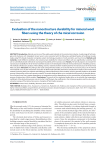
Статья научная
Introduction. Mineral wool is one of the widely used materials in the construction industry. A wide range of technologies and structures with integrated mineral wool is also connected with the following: ventilated facades of buildings, facades made using FICS (facade insulation composite system) technology, insulation of roofs and attics, and much more. Methods and materials. Under different conditions, the nanostructure durability for mineral wool fibers will vary significantly. Currently, there are no scientifically based methods for assessing the durability of the nanostructure. Results. The article proposes to evaluate the nanostructure durability for the of mineral wool fibers based on the developed method of chemical destruction of building ceramics. The methods of laboratory analysis of the building ceramics material and their modernization for the nanostructure of mineral wool fibers are given. Discussion. According to the results of experimental studies, it was found that the corrosion process in the mineral wool material occurs by the mechanism of reaction of alkali metal hydroxides with silicon and aluminum oxides in the mineral wool material, removing them into solution and leading to chemical destruction of the material, which is generally similar to the studied process of destruction of the wall ceramics material. The results obtained allow us to conclude that the process of chemical destruction of mineral wool has a greater dependence on temperature and less dependence on the concentration of hydroxides than the process of destruction of brick material. Conclusions. The results of the conducted studies allow us to calculate the temperature coefficient of the destruction process rate in the Van't-Hoff formula, the coefficients in the Arrhenius equation and the value of the activation energy of the destruction process. Examples of field studies are given.
Бесплатно
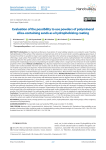
Статья научная
Introduction. An important performance characteristic of many building materials is one related to water. Therefore, hydrophobization of the surface of the material is an important task, which at the current level is solved by applying special means. It has been found that it is possible to impart water repellent properties to the surface by using polydisperse mineral materials capable of forming a rough surface. Fine powder from polymineral sand is proposed to be used as a hydrophobisate. The revealed functional relationship between the specific surface and the value of the average particle diameter of the powders, having a linear character, allows assessing their morphological structure and predicting the powder's ability to form a rough layer that enhances the water repellent properties of the surface. Methods and Materials. Four deposits of polymineral construction sands are selected as raw materials. The samples were washed and dried. Then their size modulus and true density were determined. To obtain finely dispersed powders, the raw material was ground by dry dispersion. Particle dimensional characteristics were determined by photon-correlation spectroscopy. The visual characteristic of the shape and size of the particles is determined on a laser analyzer. The specific surface area of highly dispersed rock systems was determined by gas sorption, according to BET theory. Measurement of the edge stationary wetting angle was carried out by applying a drop of distilled water to the powder surface. Results and Discussion. The dimensional characteristics of the obtained fractions showed that with a milling time (30 min) for the sands of all deposits, the average particle size (d) is 360±45 nm. At the same time, the sands of the Kenitsy and Nekhtskoye deposits have the highest values of specific surface area (Ssp). The functional relationship between the Ssp of the powders tested and 1/d was determined. The resulting linear dependencies were characterized by mathematical expressions of the form Ssp = (a/d)+b, a where reflects the rate of change in the specific surface value as the average particle diameter of the samples changes; b – is the regression line shift associated with the asymmetric shape of the particles and the non-uniformity (roughness) of the surface. It has been found that as the value of b increases, the degree of inhomogeneity of the surface formed by these particles also increases. Determination of the edge wetting angle of the surface of the powders under study showed that as the grinding time increased, the wetting angle (surface hydrophobicity) increased. So, for the surface of the fine powder of the Nekhtskoye deposit, the wetting edge angle reaches a value (114о) close in magnitude to superhydrophobicity (120о). Conclusion. The experiments showed the validity of the proposed working hypothesis related to the possible assessment of surface hydrophobicity by the experimentally determined dependence of Ssp = f (1/d). This technique can be used to select mineral powders whose fine systems are capable of hydrophobizing (if necessary hydrophilizing) the surface of the material.
Бесплатно
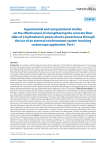
Статья научная
Introduction. In accordance with the Federal Law of the Russian Federation ”On the Safety of Hydraulic Structures“, it is necessary to ensure the long-term safety and reliability of operating structures at hydroelectric power plants (HPPs). In a run-of-river HPP, the "headwall-turbine hall floor slab" system serves as the main load-bearing structure, absorbing a variety of external forces and loads during the operation of the turbine hall within the HPP. Over time, surveys have revealed the intensive cracking in reinforced concrete floor slabs, reducing their bearing capacity. To ensure safe operation and prolong the life cycle of the HPP, it is necessary to strengthen the reinforced concrete floor slabs of the turbine hall with external reinforcement, preferably with composite carbon tapes having high strength, low weight, dielectric qualities and other positive characteristics. At the same time, the method of installing carbon tapes should ensure that finely dispersed conductive dust does not form, since the reinforced concrete structures of the HPP turbine hall, saturated with electrical equipment that powers the HPP, are reinforced. It is also necessary to ensure that the operation of the strengthened reinforced concrete floor slab with an external reinforcement system with carbon tapes is monitored over time by means of embedded control and measuring equipment. The solution of the tasks set in the present experimental and computational studies made it possible to substantiate the effectiveness of strengthening the floor slab with external reinforcement based on the use of carbon tapes and to implement it in the HPP turbine hall. Materials and methods. The reinforced concrete floor slab in the HPP turbine hall, which has been subjected to both external and non-design loading during operation, is the object of this study. The cracking and deflections recorded by the surveys led to the need for experimental studies in field conditions, including using a load weighing 150 kN. The stresses in the working metal stretched reinforcement were determined before and after the external reinforcement device with FibArmTape-530/300 carbon tapes. The stress in the carbon tapes was also determined. The experiments of reinforced concrete floor slab models’ fragments of the stretched zone were carried out in laboratory conditions in order to determine the effectiveness of the reinforcement using a new method of installing carbon tapes on a concrete surface. These experiments were carried out using a tensile breaking machine and confirmed the positive effect of using a new method of carbon tape device, preventing the formation of finely dispersed conductive dust in the operating electrical installations of the HPP turbine halls. At the same time, the necessary strength of reinforced structures is obtained. In order to determine the formed stress-strain state of the reinforced concrete floor slab of the turbine hall, computational studies were performed taking into account the revealed nature of cracking. Stresses in stretched working reinforcement under various loads before and after strengthening, as well as stresses in carbon tapes, were determined. Using the calculations performed, a schematic diagram of reinforced concrete floor slab strengthening is proposed – the pitch of the carbon tapes and the number of layers of the composite material. Results. From the results of the experimental studies of models fragments of the reinforced concrete floor slab stretched zone that have characteristics of hydraulic structures (concrete of class B15 and B25, low coefficient of reinforcement μs = 0.00445÷0.00692, it follows that an increase in strength of 1.62–1.96 times was obtained for composite carbon tapes on a concrete surface strengthened by a new method (applied to HPP). As a result of the strengthening of the reinforced concrete floor slab with external reinforcement using a new method (applied to HPP) for the installation of carbon tapes, as a result of experimental studies in the turbine hall of the HPP, a stress redistribution was established between metal working reinforcement and carbon tapes, which were included in joint work with the floor slab with the formation of tensile stresses in the tapes. Under loading on a reinforced floor slab with 150 kN, the tensile stresses in the metal reinforcement decreased by 1.8–2.9 times (directions – along the flow and across the flow) with the formation of almost equivalent stresses in carbon tapes of the external reinforcement. In order to calculate the changes in the stress-strain state of the floor slab of the turbine hall of the HPP building (with cracking, with support that is not designed in some places under the influence of non-designed loads) strengthening with external reinforcement with carbon tapes, a spatial finite element model was developed and applied.
Бесплатно

Статья научная
Introduction. In accordance with the Federal Law of the Russian Federation “On the Safety of Hydraulic Structures”, it is necessary to ensure the long-term safety and reliability of operating structures at hydroelectric power plants (HPP). In a run-of-river HPP, the “headwall-turbine hall floor slab” system serves as the main load-bearing structure, absorbing a variety of external forces and loads during the operation of the turbine hall within the HPP. Over time, surveys have revealed the intensive cracking in reinforced concrete floor slabs, reducing their bearing capacity. To ensure safe operation and prolong the life cycle of the HPP, it is necessary to strengthen the reinforced concrete floor slabs of the turbine hall with external reinforcement, preferably with composite carbon tapes having high strength, low weight, dielectric qualities and other positive characteristics. At the same time, the method of installing carbon tapes should ensure that finely dispersed conductive dust does not form, since the reinforced concrete structures of the HPP turbine hall, saturated with electrical equipment that powers the HPP, are reinforced. It is also necessary to ensure that the operation of the strengthened reinforced concrete floor slab with an external reinforcement system with carbon tapes is monitored over time by means of embedded control and measuring equipment. The solution of the tasks set in the present experimental and computational studies made it possible to substantiate the effectiveness of strengthening the floor slab with external reinforcement based on the use of carbon tapes and to implement it in the HPP turbine hall. Materials and methods. The reinforced concrete floor slab in the HPP turbine hall, which has been subjected to both external and non-design loading during operation, is the object of this study. The cracking and deflections recorded by the surveys led to the need for experimental studies in field conditions, including using a load weighing 150 kN. The stresses in the working metal stretched reinforcement were determined before and after the external reinforcement device with FibArmTape-530/300 carbon tapes. The stress in the carbon tapes was also determined. The experiments of reinforced concrete floor slab models’ fragments of the stretched zone were carried out in laboratory conditions in order to determine the effectiveness of the reinforcement using a new method of installing carbon tapes on a concrete surface. These experiments were carried out using a tensile breaking machine and confirmed the positive effect of using a new method of carbon tape device, preventing the formation of finely dispersed conductive dust in the operating electrical installations of the HPP turbine halls. At the same time, the necessary strength of reinforced structures is obtained. In order to determine the formed stress-strain state of the reinforced concrete floor slab of the turbine hall, computational studies were performed taking into account the revealed nature of cracking. Stresses in stretched working reinforcement under various loads before and after strengthening, as well as stresses in carbon tapes, were determined. Using the calculations performed, a schematic diagram of reinforced concrete floor slab strengthening is proposed – the pitch of the carbon tapes and the number of layers of the composite material. Results. From the results of the experimental studies of models fragments of the reinforced concrete floor slab stretched zone that have characteristics of hydraulic structures (concrete of class B15 and B25, low coefficient of reinforcement μs = 0.00445÷0.00692, it follows that an increase in strength of 1.62–1.96 times was obtained for composite carbon tapes on a concrete surface strengthened by a new method (applied to HPP). As a result of the strengthening of the reinforced concrete floor slab with external reinforcement using a new method (applied to HPP) for the installation of carbon tapes, as a result of experimental studies in the turbine hall of the HPP, a stress redistribution was established between metal working reinforcement and carbon tapes, which were included in joint work with the floor slab with the formation of tensile stresses in the tapes. Under loading on a reinforced floor slab with 150 kN, the tensile stresses in the metal reinforcement decreased by 1.8–2.9 times (directions – along the flow and across the flow) with the formation of almost equivalent stresses in carbon tapes of the external reinforcement. In order to calculate the changes in the stress-strain state of the floor slab of the turbine hall of the HPP building (with cracking, with support that is not designed in some places under the influence of non-designed loads) strengthening with external reinforcement with carbon tapes, a spatial finite element model was developed and applied.
Бесплатно
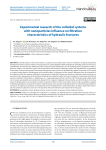
Статья научная
Colloidal systems in form of emulsions or suspensions are widely used in various of industries including oil-gas fields development industry. Invert emulsions and suspensions are actively applied in fields development, including enhanced oil recovery, intensification of oil production, drilling and wells workover. Results of laboratory tests for studying physical properties of heterogeneous systems as an emulsion system with nanoparticles and emulsion-suspension system with nanoparticles are presented in this paper. Having unique physical and chemical properties these systems can be effectively applied in upstream of oil and gas as a water-limiting agent or blocking pack with reversible effect. In framework of this research, laboratory tests for evaluation of the influence of the new systems on filtration characteristics of hydraulic fractures are carried out. Laboratory tests are planned in accordance with requirements of international standards and conducted under the closest conditions to subsurface thermal and pressure conditions of formations STyr Abdylovskoe, SBASh Yugomashevskoe and YuS-2 and YuS-4 of Tortasinskoe oil-gas fields. Based on the results, permeability and conductivity indexes of the models of hydraulic fractures before and after filtration of the new types of colloidal systems are calculated. In order to evaluate an efficiency of the new systems and to study a possibility to regulate its blocking properties an analysis of the impact made by a type and a quantity of nanosized solids on to the blocking properties is carried out. An optimal concentration of nanoparticles in the compositions for a range of formation conditions of particular carbonate and sandstone subsurface reservoirs of oil-gas fields of Russian Federation are represented in this paper.
Бесплатно
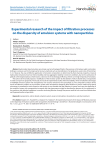
Статья научная
Hydrocarbon based emulsions are actively used as technological fluids in the processes of oil and gas wells construction, drilling-in, workover, and in the improved oil recovery methods such as intensification of oil production, water shut-off and others [1, 2]. However, the area of effective application of emulsion compositions is determined by their physical properties. Classical hydrocarbon emulsions have low thermal stability and lose aggregative stability in reservoir conditions, due to the coalescence of globules of the dispersed phase, which leads to a decrease in the technological efficiency of their use in high-temperature formations. The authors of the article propose a modification of the emulsion system by the addition of silicon dioxide (SiO2) nanoparticles in order to improve its properties. Previously, the results of experimental studies of thermal stability, which revealed the advantages of modified emulsion system with nanoparticles over classical emulsions were presented. [3]. The comparative analysis of the results of laboratory studies on the emulsion system with nanoparticles dispersity after filtration in porous media using optical microscopy is presented in article. Based on the analysis it was revealed that after filtration in natural rock cores the dispersity of the emulsion system with nanoparticles increased, and that phenomenon might be described by absence of the coalescence in the emulsion, and globules breakdown to smaller size during filtration through the porous media of rock cores from Abdulovskoe and Yugomashevskoe oil-gas fields.
Бесплатно
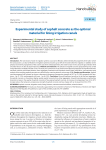
Experimental study of asphalt concrete as the optimal material for lining irrigation canals
Статья научная
Introduction. The main losses of water in irrigation systems occur due to filtration, determined by the properties of the soil in which the canal passes. Loss due to filtration in irrigation systems amounts up to 50% of the water taken for irrigation. In addition to the physical and chemical properties of the soil, the size of the wetted perimeter, the water horizon in the canal, the groundwater level and other factors are also of great importance. Methods and materials. The selection of asphalt concrete proportioning was carried out by laboratory method and Tsiat curves. The study was carried out on the chemical and physical properties of Shymkent bitumen and their mixtures with Aktau bitumen; loess aggregate, limestone and Shymkent cement were used. Micro- and nanostructural analysis of the resulting asphalt concrete was carried out by scanning electron microscope (SEM). Results and discussion. Asphalt concrete prepared with cement has shown a decrease in temporary compressive strength at 50°C by 70–38%, prepared with limestone – by 47–33%, and prepared with loess – by 66–20%. Conclusion. Ground limestone turned out to be the best aggregate for asphalt concrete, as it produces higher quality asphalt concrete than other aggregates. Ground limestone gives a particularly dramatic increase in the quality of asphalt concrete in fine-grained asphalt concrete. An increase in temperature from 20 to 50°C sharply reduces the temporary compressive strength of asphalt concrete and less sharply with an increase from 50 to 70°C.
Бесплатно

Experimental study of heat-insulating aerogel-based nanomaterials
Статья научная
Research and synthesis of materials with fundamentally new properties play the key role in the development of modern science and technology. The most perspective materials are considered to be aerogels: nanostructured materials with many useful properties. The mesoporous structure of airgels determines their widespread use, both in industry and in science. Over the past few decades, nanostructured silica-based material has become an integral part of many industry segments: thermal and noise insulation, electronics, chemistry, medicine, environmental protection, industrial and fire safety, energy, aerospace industry, consumer goods and military technology. The article discusses an experimental study of the heat-shielding properties of a heat-insulating material based on silicon oxide airgel – Insuflex. This is a flexible rolled material used for thermal insulation of elements of technological installations, pipelines, valves and control valves. Using the method of ordinal statistics, the exponential dependence of the coefficient of thermal conductivity of the airgel on the average temperature of the sample is determined. The results obtained indicate the possibility of energy-efficient use of the material in heat supply and heat consumption systems.
Бесплатно
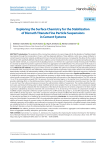
Статья научная
Introduction. The evolution of the construction industry in its current stage calls for the alteration of traditional building materials through the incorporation of nano- and fine-dispersed additives. These additions confer new, unique attributes to cement-based construction materials, enabling control over structure formation processes. Consequently, this allows for the creation of materials with specifically defined characteristics. Additives can be introduced into the cement composite during the joint grinding with clinker minerals, as a component of dry building mixture, or in the form of a suspension instead of mixing water. Therefore, it is essential to obtain fine particles suspensions resistant to aggregation and sedimentation. Thus, the purpose of this study is to obtain stabilized suspensions of bismuth titanate fine particles for cement systems and to study the properties of modified cement stone. Materials and methods. The purpose of this work was to establish the optimal concentration of polycarboxylate plasticizer in industrial water, necessary for the stabilization of fine bismuth titanate suspensions using surface tension and conductometric determination methods, the sedimentation stability of the obtained suspensions and the effect of ultrasonic exposure, as well as the physical and mechanical characteristics of cement stone modified with the obtained suspensions. Results and discussion. In order to establish the optimal concentration of the plasticizer necessary to obtain stable suspensions of bismuth titanate particles, the critical micelle concentration (CMC) for the plasticizer was determined with tap water as the dispersed medium. The CMC value was 1.3 g/l. If the concentration exceeds CMC, the process of micelle formation begins. In the micellar form, the plasticizer no longer provides stabilizing effect on the additive particles, therefore, the concentration of the plasticizer should be lower than the CMC. It was also found that ultrasound exposure increases the sedimentation stability of suspensions. The resulting stabilized suspensions were used instead of mixing water to obtain modified cement stone samples. There is an increase in the compressive strength of cement stone samples obtained after the introduction of fine bismuth titanate into the cement composite in the form of water suspensions stabilized by ultrasonic treatment with concentrations of 10, 30 and 50 g/l. The increase in compressive strength of modified samples compared to reference sample was from 24 to 33 MPa at first day age (by 13, 25 and 38% respectively), and from 80 to 93 MPa at 28 days age (by 4, 9 and 16%). Compressive strength of samples modified with bismuth titanate suspensions after ultrasonication compared to reference sample with plasticizer increased mostly at the first and third days age: from 29 to 42 MPa (by 31, 38 and 45%) and from 53 to 70 MPa (by 28, 30 and 32%) respectively. Conclusion. As a result of the research carried out in this study, the Critical Micelle Concentration (CMC) of a polycarboxylate plasticizer was determined, optimal for stabilizing fine-dispersed additive of bismuth titanate for cement systems, the effectiveness of ultrasonic treatment to achieve sedimentation stability of the obtained suspensions of the additive was confirmed, an increase in the strength characteristics of modified cement stone samples was established both in the initial hardening periods and at 28 days age. The results allow to consider a cement composite with fine bismuth titanate as a basis for obtaining building materials of new generation.
Бесплатно






